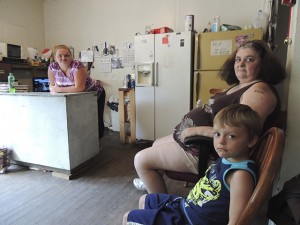Conservative think tanks have spawned a cottage industry churning out dubious studies purporting to show that poor families are living high on the hog on public benefits, a claim that anybody who has actually experienced poverty in America would find laughable.

Renee Adams, left, posing with her mother Irene Salyers and son Joseph, 4, at their produce stand in Council, Va. (AP Photo/Debra McCown)
These papers are then amplified by the right-wing media, forming the basis for calls to further eviscerate a social safety net that’s already been tattered and torn by 30 years of ascendant neoliberalism.
The latest addition to the genre is a study published this week by Michael Tanner and Charles Hughes at the CATO Institute. They calculated the maximum benefits of every federal anti-poverty program in which a single parent with two kids could participate, including things like tax credits for the working poor and supplemental nutrition and health benefits for pregnant women and young children, called it all “welfare” – a word that has long been unpopular to a public that otherwise supports measures to help the neediest – and used it to form the claim that “welfare” provides a perfectly decent quality of life.
Running the numbers in all 50 states and the District of Columbia, Tanner and Hughes claim that “the current welfare system provides such a high level of benefits that it acts as a disincentive for work” and urge lawmakers to “consider ways to shrink the gap between the value of welfare and work by reducing current benefit levels and tightening eligibility requirements.”
But the paper shouldn’t be taken at face value because the authors’ abundant caveats show that their study measures neither the reality of poverty in America, nor that of the public programs designed to fight it.
Tanner and Hughes acknowledge that “surveys of welfare recipients consistently show their desire for a job.” They acknowledge that a significant share of those receiving public benefits are working – Walmart employees, for example, famously rely on public assistance to get by, meaning that taxpayers effectively subsidize the Walton family’s vast fortunes. And they note that programs like TANF are time-limited – to a maximum of 60 months except in most cases.
They also acknowledge the central flaw in their conclusion: in real life the “typical” family in their study doesn’t come close to receiving the maximum benefit from every single program for which they’re eligible. But here the authors’ caveat doesn’t go far enough. Due largely to the fact that eligibility requirements have already become harder to overcome, these programs are helping fewer poor families get by. In 2009, around three out of four poor families with kids weren’t getting any TANF benefits. At the height of the economic crash, about 25 percent of those eligible for food stamps weren’t receiving them; during better times, that number hovers around 40 percent. And as the CATO study concedes, six out of seven poor families aren’t getting housing assistance.
So a study that claims to tell us about the “typical” poor family is really describing a rarity — the equivalent of a four-leaf clover. But the purpose of these studies isn’t to inform good policymaking. They feed a narrative that the poor are lazy and undeserving, and provide wonky cover for further weakening our social safety net. When studies like this one are picked up by the conservative media, all of the authors’ caveats tend to be stripped away, and they become straightforward claims that poor families sit back enjoying a good life, forcing overburdened tax-payers to pick up the tab.
With one in seven Americans either unemployed or underemployed, and the sequester already resulting in deep cuts to programs designed to help the neediest, it’s a profoundly immoral pursuit.
Correction: an earlier version of this post claimed that a household could receive TANF benefits for a maximum of 24 months.

